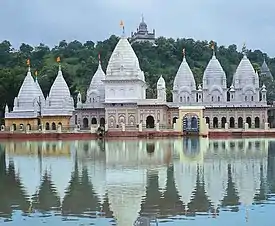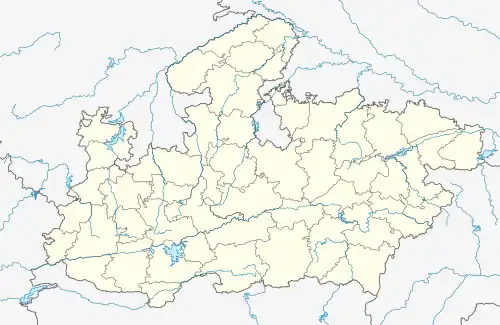Damoh | |
|---|---|
City | |
| Damoh | |
 From top, left to right:The Bade Baba Temple at Kundalpur india's cultural heritage site, Lord Shiv Temple at Bandakpur, Jain Temples near Vardhman Lake in Kundalpur, Circuit House Gate most visit place in Damoh, Rajnagar Lake Damoh lifeline of Damoh, Kirti Stambh Damoh jain historical landmark in Damoh, Nohleshwar Temple at Nohta historical architecture temple | |
 Damoh Location in Madhya Pradesh, India.  Damoh Damoh (India) | |
| Coordinates: 23°50′N 79°27′E / 23.84°N 79.45°E | |
| Country | |
| State | Madhya Pradesh |
| District | Damoh |
| Government | |
| • Type | Mayor–council |
| • Body | Damoh Municipal Corporation |
| • Mayor | Manju Rai |
| • District Magistrate | S. Krishna Chaitanya[1] |
| • MLA | Ajay Kumar Tandon[2] |
| • MP | Prahlad Singh Patel[3] |
| Elevation | 595 m (1,952 ft) |
| Population | |
| • Total | 126,219 |
| • Density | 148/km2 (380/sq mi) |
| Languages | |
| • Official | Indian English, Hindi |
| Time zone | UTC+5:30 (IST) |
| PIN | 470661 |
| Telephone code | 07812 |
| Vehicle registration | MP-34 |
| Sex rati o | 913 ♂/♀ |
| Average Literacy Rate | 86.18% |
| Website | damoh |
Damoh is a city in the Indian state of Madhya Pradesh. It is known for The Bade Baba Temple at Kundalpur, a Jain pilgrimage site. It is one of the major cities of Madhya Pradesh. The city is also the district headquarters of Damoh district.
It is the fifth-largest urban agglomeration in Madhya Pradesh. It is also known for Singrampur Nidan Waterfall, Singorgarh fort, Nohleshwar Temple,Nohta,etc.[4]
Damoh is an important Tourism, Culture, Industrial, Business Centre and Economical Hub of india and Damoh is also best cities in India for ease of doing business and services.[5]
The Bade Baba Temple at Kundalpur and Singrampur Wildlife Sanctuary Singorgarh fort are primarily tourism and culture places of Damoh where tourist comes from across the world to visit these Places and contribute the indian economy.[6]
Heidelberg Cement India's biggest Cement plant at narsinghgarh and Mysore Cements Limited at Imlai area are the popular industries situated at damoh and important for employment.[7][8]
History
Early history
Stone Age tools have been found in Singrampur Valley and it is believed that the area has been inhabited for thousands of years.[9] Around the fifth century, it was part of the empire of Guptas of Pataliputra. This has been evidenced by plaques and coins, and monuments from the reigns of Samudragupta, Chandragupta I, and Skandgupta. From the eighth to twelfth centuries, some parts of the Damoh district were in the Chedi Empire, ruled by the Kalchuri dynasty from its capital Tripuri. The temple at Nohta demonstrates Kalchuri's influence in the tenth century. Some regions of the district were under the Chandels of the Jejak-Bhukti.
Sultans
Around the beginning of the fourteenth century, the administrative centre of the Chanderi province of the Khalji dynasty was moved to Damoh.
The era of Muslim rule began in the fourteenth century. Stone carvings at Salaiya and Batiyagarh mention Khalji and Tuglaq Sultans. The Sultan of Malwa later annexed the region.
Gond and Maratha rule
In the last quarter of the fifteenth century, Sangram Shah of the Gond dynasty annexed the region into his empire organised around 52 forts. This was an era of peace and prosperity for the region. In Singrampur, Rani Durgawati attained martyrdom battling against the Mughal Empire, represented by its General Asaf Khan and his army.
Bundelas entered the region for a brief time span, after which Marathas took over in 1732. Marathas remained in control until the British annexed the Marathas kingdom after the death of Peshwa in 1888. The Diwanji ki Talaiya and the Ram Mandir were constructed by the Maratha administrators.
Modern history
Raja Hirde Shah, Lodhi king of Damoh, played an important part in the Bundela, Gond and Lodhi Uprising of 1842.[10]
Damoh took part in the struggle for independence from the British. Under the leadership of Thakur Kishore Singh of Hindoria, Raja Devi Singh of Singrampur, Pancham Singh of Karijog, Gangadhar Rao of Mangarh, Raghunath Rao, Mejban Singh, and Govind Rao were among those who took part in the 1857 revolt.
Damoh suffered from famine in 1896-97 and 1900. By 1899 the India Midland Railway had completed the construction of Sagar–Damoh link and Damoh–Katni links. Freedom fighter Seth Govind Das was jailed in Damoh in 1923, and wrote a number of Hindi plays while imprisoned. In 1929, Acharya Shantisagar visited Damoh, the first such visit by a Digambar Muni to Damoh after several centuries.[11]
In 1933, Mahatma Gandhi visited Damoh. In 1946, Sagar University was established as the region's primary centre for higher education.
In 1947, with India's independence from British Raj, the Central Provinces were reorganised as the state of Madhya Pradesh. The town of Damoh had its first-degree college established in 1961 by Shiksha Prasar Samiti, a volunteer organisation.
Geography
Location
Damoh is located at 23°53′N 79°27′E / 23.88°N 79.45°E.[12] It is at an average elevation of 595 metres (1,952 ft).
Climate
| Climate data for Damoh (1981–2010, extremes 1970–2011) | |||||||||||||
|---|---|---|---|---|---|---|---|---|---|---|---|---|---|
| Month | Jan | Feb | Mar | Apr | May | Jun | Jul | Aug | Sep | Oct | Nov | Dec | Year |
| Record high °C (°F) | 33.3 (91.9) |
37.2 (99.0) |
41.0 (105.8) |
45.2 (113.4) |
49.8 (121.6) |
46.6 (115.9) |
42.6 (108.7) |
38.4 (101.1) |
38.2 (100.8) |
39.2 (102.6) |
37.0 (98.6) |
32.0 (89.6) |
49.8 (121.6) |
| Mean maximum °C (°F) | 30.5 (86.9) |
33.4 (92.1) |
38.1 (100.6) |
43.1 (109.6) |
45.9 (114.6) |
44.1 (111.4) |
37.4 (99.3) |
34.4 (93.9) |
34.8 (94.6) |
35.8 (96.4) |
33.9 (93.0) |
29.4 (84.9) |
45.2 (113.4) |
| Mean daily maximum °C (°F) | 25.2 (77.4) |
28.9 (84.0) |
33.7 (92.7) |
39.1 (102.4) |
42.4 (108.3) |
39.3 (102.7) |
32.7 (90.9) |
30.8 (87.4) |
31.7 (89.1) |
33.1 (91.6) |
30.1 (86.2) |
25.9 (78.6) |
32.7 (90.9) |
| Mean daily minimum °C (°F) | 8.5 (47.3) |
11.9 (53.4) |
17.1 (62.8) |
22.3 (72.1) |
26.8 (80.2) |
26.8 (80.2) |
24.5 (76.1) |
23.6 (74.5) |
22.9 (73.2) |
19.0 (66.2) |
13.8 (56.8) |
9.1 (48.4) |
18.9 (66.0) |
| Mean minimum °C (°F) | 4.0 (39.2) |
7.2 (45.0) |
11.9 (53.4) |
17.1 (62.8) |
22 (72) |
22.7 (72.9) |
22.3 (72.1) |
21.7 (71.1) |
20.2 (68.4) |
14.0 (57.2) |
9.3 (48.7) |
5.9 (42.6) |
4.1 (39.4) |
| Record low °C (°F) | 0.5 (32.9) |
1.6 (34.9) |
7.0 (44.6) |
14.6 (58.3) |
19.0 (66.2) |
19.8 (67.6) |
18.0 (64.4) |
19.0 (66.2) |
15.0 (59.0) |
10.5 (50.9) |
5.0 (41.0) |
2.5 (36.5) |
0.5 (32.9) |
| Average rainfall mm (inches) | 11.6 (0.46) |
17.8 (0.70) |
8.4 (0.33) |
3.7 (0.15) |
8.6 (0.34) |
119.4 (4.70) |
305.4 (12.02) |
435.1 (17.13) |
181.4 (7.14) |
32.7 (1.29) |
13.8 (0.54) |
7.7 (0.30) |
1,145.6 (45.10) |
| Average rainy days | 1.1 | 1.6 | 0.8 | 0.4 | 0.7 | 6.2 | 12.8 | 15.7 | 8.1 | 1.8 | 0.8 | 0.7 | 50.6 |
| Average relative humidity (%) | 67 | 60 | 48 | 37 | 38 | 55 | 79 | 84 | 81 | 65 | 60 | 65 | 61 |
| Source: India Meteorological Department[13][14] | |||||||||||||
Demographics
According to the 2001 India census,[15] Damoh city had a population of 112,160 (total urban population is 147,661). Males constituted 53% of the population and females 47%. Damoh had an average literacy rate of 73%, above the national average of 59.5%: male literacy was 89% and female literacy was 66%. 14% of the population was under 6 years of age.
Government and administration
Damoh city has a Nagar Palika Parishad with the elected head Malti Asati.[16] Tarun Rathi is the current DM & Collector for the Damoh District.[17] The current Member of Legislative Assembly from Damoh constituency is Mr. Ajay Kumar Tandon.
Notable people
- Sunil Lahri, actor, best known for portraying Lakshmana in the television show Ramayan (1987-1988)[18]
References
- ↑ "Collector of Damoh 2021: Collector Site".
- ↑ "MLA of Damoh 2021 By Election: Ajay Kumar Tandon".
- ↑ "Member of Parliament Damoh: Prahlad Singh Patel".
- ↑ "Office Site:Damoh.nic.in".
- ↑ "Official Site:Damoh.nic.in".
- ↑ "Official Site:Damoh.nic.in".
- ↑ "Official Site:Damoh.nic.in".
- ↑ "Official mycem Site:www.mycemco.com".
- ↑ "History | Damoh - A District of Madhya Pradesh - A City of Grace and Affection". www.damoh.nic.in. Archived from the original on 16 November 2017. Retrieved 29 June 2018.
- ↑ "Bundela Uprising of 1842".
- ↑ Charitra Chakravarti, Divakar, Sumeruchandra, 1953, Shanti Prakashan Sivni, p. 257-258
- ↑ Falling Rain Genomics, Inc - Damoh
- ↑ "Station: Damoh Climatological Table 1981–2010" (PDF). Climatological Normals 1981–2010. India Meteorological Department. January 2015. pp. 223–224. Archived from the original (PDF) on 5 February 2020. Retrieved 28 December 2020.
- ↑ "Extremes of Temperature & Rainfall for Indian Stations (Up to 2012)" (PDF). India Meteorological Department. December 2016. p. M116. Archived from the original (PDF) on 5 February 2020. Retrieved 28 December 2020.
- ↑ "Census of India 2001: Data from the 2001 Census, including cities, villages and towns (Provisional)". Census Commission of India. Archived from the original on 16 June 2004. Retrieved 1 November 2008.
- ↑ Municipal Corporation President
- ↑ collector profile
- ↑ "दमोह का पम्मी 150 लड़कों को पछाड़कर बना था रामायण में लक्ष्मण". Dainik Bhaskar. 22 July 2018. Retrieved 7 October 2023.
External links
 Damoh travel guide from Wikivoyage
Damoh travel guide from Wikivoyage- Damoh website
- Damoh News website Archived 9 December 2022 at the Wayback Machine